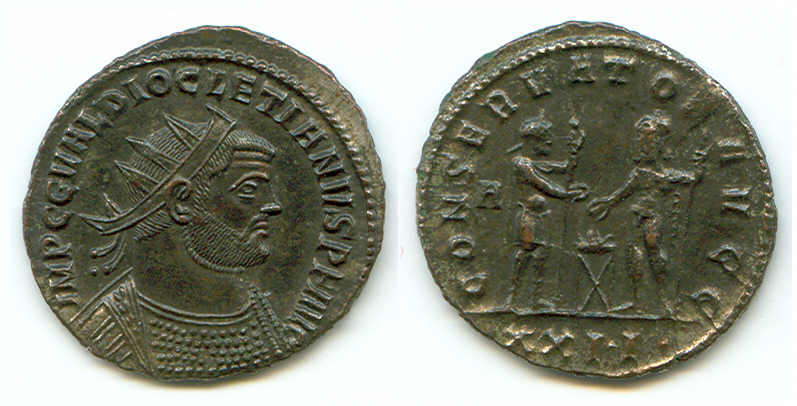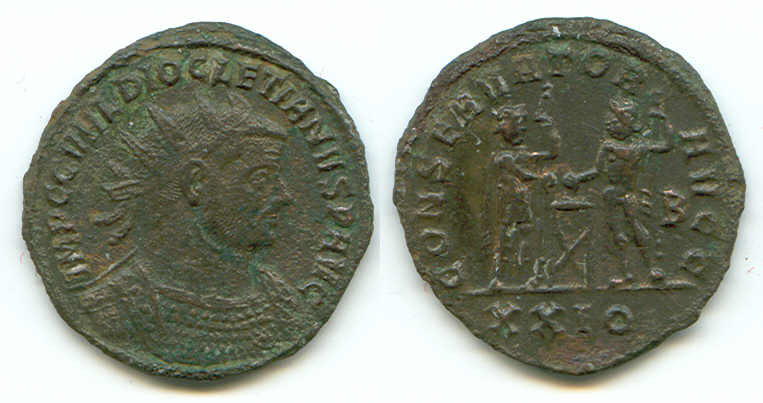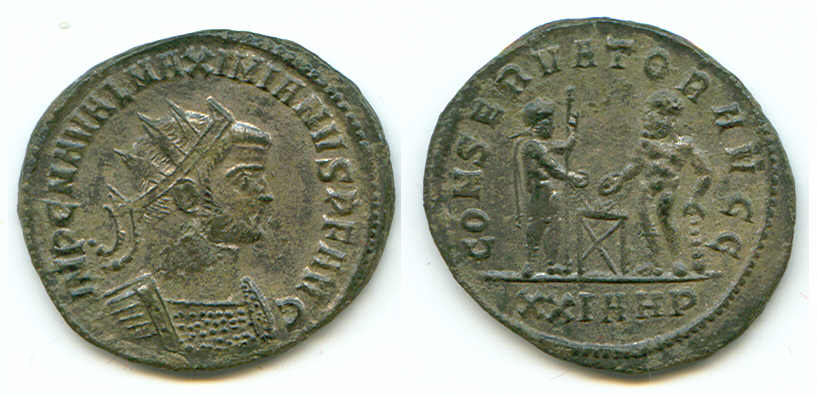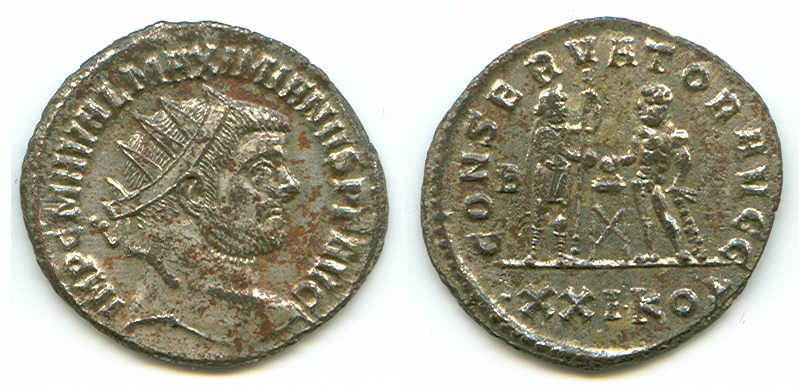

Coded officina mintmarks of the Roman emperors Diocletian and Maximiman at Siscia (289-290 AD)
Late Roman coins were minted at numerous mints and each mint was subdivided into "officinae" (plural, "officina" singular)-- workshops that were more or less separate. On one occasion, in 289-290 AD, the officina number was marked--coded--on coins in a unique way.
At first glance, the Diocletian antoninianus at the uupper right is not special except for condition. Read on to find out what makes the mintmark truly unusual.
Sometimes the coins do not indicte the officina number explicitly. For example, we know that under under Severus Alexander, 222-235 AD, the mint had six officinae but the coins do not show officinae marks. However, at other times, the officinae are clearly distinguished by marks on the coin. For example, under Philip his well-known series of animal types for the Saecular games of 248 AD (commeorating the 1000th anniversary of Rome's founding) has six officinae clearly numbered I, II, III, IIII, V, and VI in the exergue (the numerals are prominent below the line on which the animals stand).
By the time of Diocletian officina marks are a regular part of the mintmark. However, at Siscia in 289-290 they took on an unusual form on one issue. To understand and decypher them some of the history is essential. Diocletian promoted Maximian to co-emperor in 286. Diocletian proceeded to identify himself with Jupiter (Jove) and Maximian with Hercules. In history books they are sometimes called by these titles, the Jovian (Iovian) and Herculian emperors, and Maximian is sometime called "Herculius." These titles became part of the mintmarks at Siscia for a short time.
Siscia had 3 officinae, commonly denoted with the first three Greek letters, A, B, and Γ (alpha, beta, and gamma), marked clearly on the coins. For some reason they decided to, in addition, use the Jovian and Herculian titles to repeat that information by dividing each name into three parts and assigning the first part to A, the second to B, and the third to Γ. Here are six coins illustrating the six combinations -- each emperor from each of the three officianae.
Jove = IOVI = IOBI = I / O / BI
Hercules = HRKOYΛI = HR / KOY / ΛI
Click on images to increase their sizes.

Diocletian
XXI ° I° with A, for the first officina, in the left field
The "XXI" is the normal mark of the denomination.
The "I" begins the spelling of IOVI = IOBI in Greek.
The reverse type of each Diocletian piece is CONSERVATOR AVGG, emperor standing right and Jupiter standing left, each holding a patera in his right hand over a flaming altar on a tripod and a vertical scepter in his left.

Diocletian
XXI O
The O is the second letter in "IOBI"
The B for 2 is in the right field

Diocletian
º XXI ° BI °
The BI is the final part of "IOBI"
Γ, for the last officina, 3, is in the left field

Maximian
XXI A HP, with the A following XXI
and not in the field as in the previous examples.
The HP is the first part of Hercules = HRKOYΛI
The reverse type of each Maximian piece is CONSERVATOR AVGG (the same legend as for Diocletian), emperor standing right and Hercules standing left, each holding a patera in his right hand over a flaming altar on a tripod. The emperor has a vertical scepter in his left hand and Hercules rests his left arm on his club.

Maximian
°XXI KOY
The KOY is the middle part of Hercules = HRKOYΛI
B = 2, in left field

Maximian
XXI Γ ΛI
Γ = 3 is the last officina and ΛI is the last part of Hercules = HRKOYΛI
RIC (volume V, part II) lists many varieties, with the main officina letter in various places and with and without dots in the exergual legend. These six pieces show the six major combinations.
I salute the researcher who figured out what the Romans were doing at Siscia with these odd mintmarks. Gert Boersema states in an article on "The translation of the codewords AEQVITI, IOBI and HPKOYΛI" (footnote 8) that it was discovered by Von Kolb in Vienna and who published it in 1872. It was already known to the author of RIC V (page 211), Percy Webb, in 1927.
Return to the main site, Ancient Greek and Roman Coins.